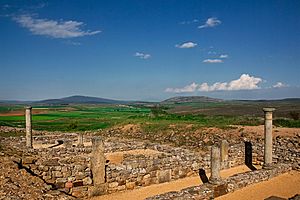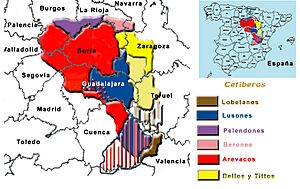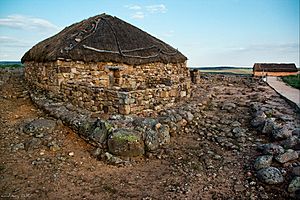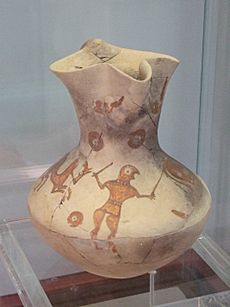Numantia facts for kids
|
Numancia
|
|
 |
|
| Location | Garray (Soria), Spain |
|---|---|
| Coordinates | 41°48′34.51″N 2°26′39.33″W / 41.8095861°N 2.4442583°W |
| Type | Archaeological site |
| History | |
| Cultures | Celtiberian |
| Type | Non-movable |
| Criteria | Archaeological site |
| Designated | 25 August 1882 |
| Reference no. | RI-55-0000001 |
Numantia (which is Numancia in Spanish) was an ancient town built by the Celtiberians. The Celtiberians were a group of people who lived in ancient Spain. The remains of Numantia are found on a hill called Cerro de la Muela, near the modern town of Garray in Spain.
Numantia is very famous because of its brave stand against the powerful Roman Empire. For many years, the people of Numantia fought against the Romans in what were known as the Celtiberian Wars. In 133 BC, after a long and difficult fight, the Romans finally managed to defeat Numantia.
Contents
History of Numantia

Numantia was an Iron Age hill fort. This means it was a fortified town built on a hill during the Iron Age. It was important because it controlled a place where people could cross the Duero River.
Historians believe Numantia was part of the Arevaci people. The Arevaci were a Celtiberian tribe. They were a mix of local Iberian people and Celts who moved into the area around 600 BC. They lived near Numantia.
Early Conflicts with Rome
Numantia first had a big fight with Rome in 153 BC. At that time, Numantia helped people from another town called Segeda. The leader of Segeda managed to defeat a Roman army.
The Romans then tried to attack Numantia. They even used war elephants, but they couldn't win. The people of Numantia were very strong fighters.
In 137 BC, something amazing happened. A huge Roman army of 20,000 soldiers actually surrendered to the people of Numantia! Numantia only had between 4,000 and 8,000 people. A young Roman officer named Tiberius Gracchus signed a peace treaty with Numantia. This saved the Roman army from being completely destroyed.
The Final Siege
The last and most famous attack on Numantia began in 134 BC. The Roman general Scipio Aemilianus Africanus was put in charge. He had a massive army of 30,000 soldiers.
Scipio decided to completely surround Numantia. He built a huge barrier, about 9 kilometers (5.6 miles) long, around the city. This barrier had towers, deep ditches, and sharp spikes to stop anyone from getting in or out.
The people of Numantia refused to give up. But because they were completely surrounded, food quickly became scarce. After eight months, most of the people inside decided they would rather die than become slaves.
After 13 months of the siege, a few hundred of the remaining people decided to burn their city down. They did this before finally surrendering to the Romans. This showed their incredible determination and love for freedom.
After the Siege
After Numantia was destroyed in 133 BC, people still lived there in the 1st century BC. The town was rebuilt with a regular street plan, but it didn't have large public buildings like before.
The town started to decline in the 3rd century AD. However, people were still living there in the 4th century. Later, in the 6th century, there are signs that the Visigoths occupied the site.
Excavation and Conservation
For a long time, no one knew exactly where Numantia was. Some people thought it was in a different area. But in 1860, a person named Eduardo Saavedra found the correct location in Garray, Soria.
In 1882, the ruins of Numantia were officially declared a national monument in Spain. This means they are protected by the government.
In 1905, a German archaeologist named Adolf Schulten started digging at the site. He found the Roman camps that Scipio Aemilianus had built around the city during the siege. Today, regular excavations are still happening at Numantia.
Museums and Discoveries
Many objects found at Numantia are on display in the Numantine Museum of Soria in Spain. This museum also helps to show the ruins at the actual site of Numantia.
Some objects from Numantia are also in the Romano-Germanic Central Museum in Germany. This is because Adolf Schulten took some items there during his excavations.
Symbolism of Numantia
The Siege of Numantia was written about by several Roman historians. They admired the strong sense of freedom of the ancient Iberians. They also respected their fighting skills against the powerful Roman armies.
In Spanish Culture
Numantia has become a powerful symbol in Spanish culture.
- Miguel de Cervantes, who wrote Don Quijote, also wrote a play about the siege. It is called El cerco de Numancia.
- The poet Antonio Machado mentioned Numantia in his poetry book Campos de Castilla.
- More recently, Carlos Fuentes wrote a short story about the event called "The Two Numantias."
Several ships in the Spanish Navy have been named Numancia. A military group from Soria was also named batallón de numantinos. During the Spanish Civil War, a Nationalist regiment named Numancia renamed a town to Numancia de la Sagra.
The football (soccer) team from Soria is called CD Numancia.
The phrase "numantine resistance" is sometimes used. It means a very strong and determined resistance, even when things look hopeless.
See also
 In Spanish: Numancia para niños
In Spanish: Numancia para niños




